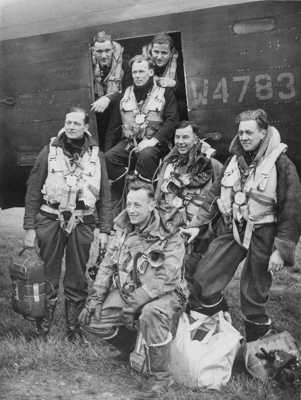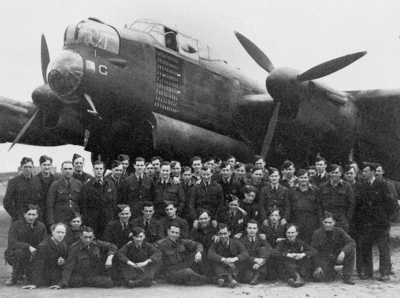In exploring history, nothing is more stimulating than seeing real objects, especially when they are as large and impressive as a Lancaster bomber.
by Peter Burness
In the gloom of the English winter’s late afternoon, a lamp gave a green light and a heavy four-engine bomber roared down the runway. The crew of seven young men, most of them from faraway Australia, might have wondered if they would ever see their base again.

Like to copy this image? Please click here first
AWM SUK12278. RAF Station Binbrook, Lincolnshire, England. May 1944. Group portrait of the crew of Lancaster bomber ‘G for George’ (W4783) of No. 460 Squadron RAAF. Flying Officer Critchley, and probably all this crew, flew ‘G for George’ on the aircraft’s last three operational missions in April 1944. Left to right: In the aircraft door; Flying Officer (FO) Samson RAAF, Wireless Operator; FO J. Critchley RAAF, Pilot; Flight Sergeant (Flt Sgt) Armstrong RAAF, Navigator. Standing; Flt Sgt Brown RAAF, Bomb Aimer; F. Shaw RAF, Rear Gunner; G. Knott RAF, Flight Engineer. In front; W. Starkey RAF, Mid-upper Gunner.
The target was Berlin, the most heavily defended centre in Europe. The airmen called it ‘The Big City’ and dreaded going there. Lancaster ‘G for George’ was one of 500 bombers heading off on the seven-hour mission. Enemy fighters would be active, the weather very bad and casualties heavy. Over the target, searchlights swept the sky, flares turned night into day in a brilliant fireworks display, and anti-aircraft gun fire -- or flak -- burst all around, while deadly night-fighters, the Messerschmitts and others, hunted for their prey. Here, and along the route, many bombers were attacked; some of them exploded in mid-air, or crashed and burned on the ground. Above Berlin, the bombers steadily held their course before releasing their lethal loads of 4000-pound blast bombs, called ‘cookies’, and bundles of incendiaries. Below, a city burned.
There were few sights more spectacular than the fireworks over Berlin. But it was a lethal display. In those minutes over the target, flying straight and level, the bombers were at their most vulnerable. for the air crews there was hardly any combat situation, on any battlefield, more dangerous than this. Despite the hazards, thousands of young men undertook this work on a regular basis, flying from airfields in Britain, usually on the darkest nights, to carry the war deep into the enemy’s territory.
Taken as an example, the operation on 16 December 1943 contains many of the elements that made bombing so hazardous for aircrew, and so destructive for the german defenders and civilians. It provides an interesting study into Bomber Command operations and the participation of ‘G for George’. That night’s operation has become the basis for Striking by night, the recently opened exhibition at the Australian War Memorial. The operation over Berlin is reconstructed in a modern sound and light display with the actual Lancaster ‘G for George’ at its centre.

Like to copy this image? Please click here first
AWM 069820. Binbrook, Lincolnshire, England. c. May 1944. Members of the ground crews of No 460 Squadron RAAF at their Royal Air Force station, in front of ‘G for George’, the squadron’s famous Avro Lancaster bomber, after the aircraft had been taken off operational flying in April 1944.
‘George’ is the Memorial’s historic Avro Lancaster Mark I bomber, one of only a few that still exist. The very survival of ‘George’, during the war and afterwards, has made it famous. Large and menacing, this aircraft flew 89 operations with 460 Squadron RAAF over Germany and occupied Europe, mostly during the height of the main British bombing offensive and against the most dangerous targets, including Pennemunde, Nuremburg, the Ruhr and Berlin. Quite simply, during the war you could not even hope that an aircraft could survive such extensive and constant front-line exposure.
‘George’ became such a wartime celebrity, and a symbol of the will to win, that it was retired from active service and flown to Australia in 1944 to help inspire and promote the war effort. When the war ended the veteran bomber was grounded and sat for a decade at Fairbairn RAAF base, Canberra, before it was finally moved into the Memorial’s Aeroplane Hall. It remained on display for 45 years and became one of the Memorial’s best-known exhibits. But old age had taken a toll. In 1999 it was removed to undergo conservation. By 2003, after extensive and skilled work, it was looking as smart, and lethal as it had 60 years ago.
‘George’ has returned to be installed in the Memorial’s ANZAC Hall, for the exciting new object theatre display, Striking by night. The exhibition opened on 6 December 2003 in the presence of gathered Bomber Command veterans. The restored bomber enables the stories of these men to be retold, in particular, new younger audiences will able to understand something of the bomber crewman’s experience through the use of modem exhibition techniques.
The exhibition enables the Memorial to draw on rich and exciting parts of its collections. The Lancaster is rare enough, and it is joined by three German Messerschmitt aircraft -- the Bf 109 fighter, the Me 262 twin-engine jet and the remarkable Me 163 rocket The Bf 109, one of the classic fighters of the Second World War, still bears its original wartime paintwork. It has not previously been exhibited in the Memorial.
There are uniforms and equipment, one of the legendary German 88-millimetre anti-aircraft flak guns, bombs, wartime posters, and the heavy metal plaque from the Mohne Dam in Germany. The latter was prised from the wall of one of the dams breached in the famous ‘dambusters’ raid. Preparing for the exhibition enabled the Memorial’s curators to select new and interesting items. The RAAF in Europe was quite diligent in collecting material for historical preservation and much of this material is now held by the Memorial.
In addition to some of the major items mentioned, extensive photographic archives, personal records, film footage and recordings have been preserved. The unique sound recording collection, created during the war, was a particularly interesting resource, to which was later added more recent interviews of former bomber men from the Memorial’s Murdoch Sound Archive. The recorded voices of the men of Bomber Command describing conditions were invaluable to the exhibition’s researchers.
Many of the wartime recordings now held by the Memorial were produced in Britain by the BBC to be played on home radios in Australia. Intended as morale boosters, the recordings kept the Australian public aware of their countrymen’s work over Europe. One of them has the voice of one of the senior Bomber Command officers, Air Vice Marshal Don Bennett, the Australian-born leader of the elite Path Finder Force. Bennett begins by saying: ‘I am very glad to have this chance of talking back home to Australia.’ He continues, in a voice reflecting the stern determination of Bomber Command:
The bomber offensive strikes at the very heart of the Fatherland itself. It has already destroyed a very large part of the enemy’s industrial capacity ... the German people are beginning, for the first time in their history, to realise that crime doesn’t pay. The war, by the bomber offensive, has been brought to their own doorstep.
In another recording an Australian pilot, Flight Sergeant Frank Mathers, talks of flying a crippled Halifax bomber home from a raid on Mulheim, Germany. The bomber had been badly hit by flak and suffered massive damage. Then, at the worst moment, the plane was attacked by a night-fighter. In an episode of great courage, devotion to duty, and sheer good luck, the Halifax’s rear gunner put a fatal burst into the Messerschmitt and shot it down. The bomber limped home to make a belly-landing in England.
Flight Sergeant Mathers was awarded the rare Conspicuous Gallantry Medal (Air). Sadly, he was killed in a later raid on Mannheim on 6 September 1943; one of more than 3000 Australians to die in the bomber campaign. The casualty rate was staggeringly high. More than one in every three Australians serving was killed. A selection of these men’s stories appears in Striking by night.
In one area of the exhibition, called Failed to return, there are extracts from airmen’s letters home, and then the fatal telegram advising next of kin that they were ‘missing’. The uniforms of some RAAF bomber crewmen killed, from the personal effects forwarded to grieving families, are displayed, including that of Flight Sergeant Rawdon Middleton, who was posthumously awarded the Victoria Cross.
At regular times, for several minutes, viewers will watch ‘G for George’ surrounded by the action and sounds of a bombing operation. They will be able to imagine something of the actual ordeal of wartime aircrew.
In exploring history, nothing is more stimulating than seeing real objects, especially when they are as large and impressive as a Lancaster bomber. The object theatre recreation, based on the night of 16 December 1943, will place ‘George’ in context. That operation was against the most stoutly defended target -- Berlin. It was flown by most of the crew, captained by Pilot Officer H. G. ‘Cherry’ Carter, who flew it most often. There was intense action over the target. Losses were so heavy that the mission would be called ‘Black Thursday’; 25 bombers were shot down and a further 29 were lost in crashes in the poor weather over Britain. Again, though, for the seventy-third time, ‘George’ came home safely. The crew survived once more; however, five of the seven would be killed or taken prisoner of war on later operations.

Like to copy this image? Please click here first
George on display at the Australian War Memorial. Photograph courtesy Australian War Memorial.
The exhibition is a tribute to the RAAF members of Bomber Command. Many veterans have helped achieve accuracy. Some have provided interviews or answers to questions, and others have written of their experiences.
A few months ago, a former Irish member of the Women’s Auxiliary Air Force wrote to the Memorial about these men and those who did not survive:
My memories are of young men, Aussie men, dancing, singing, and enjoying the moment, never to be heard of again. Shot down or KIA[killed in action]. They were young, handsome, and full of life.
This and others’ recollections capture an image of those, many still in their teens or just a few years older, who regularly faced death flying in great bombers during the bleak mid-war years or who, from 1944, supported the Allies’ efforts in finally bringing victory in Europe.
Striking by night conveys some of these extraordinary experiences.
This story was reproduced by kind permission of the Australian War Memorial. Striking by night was a feature story in issue 24 of Wartime, the official magazine of the Australian War Memorial.





